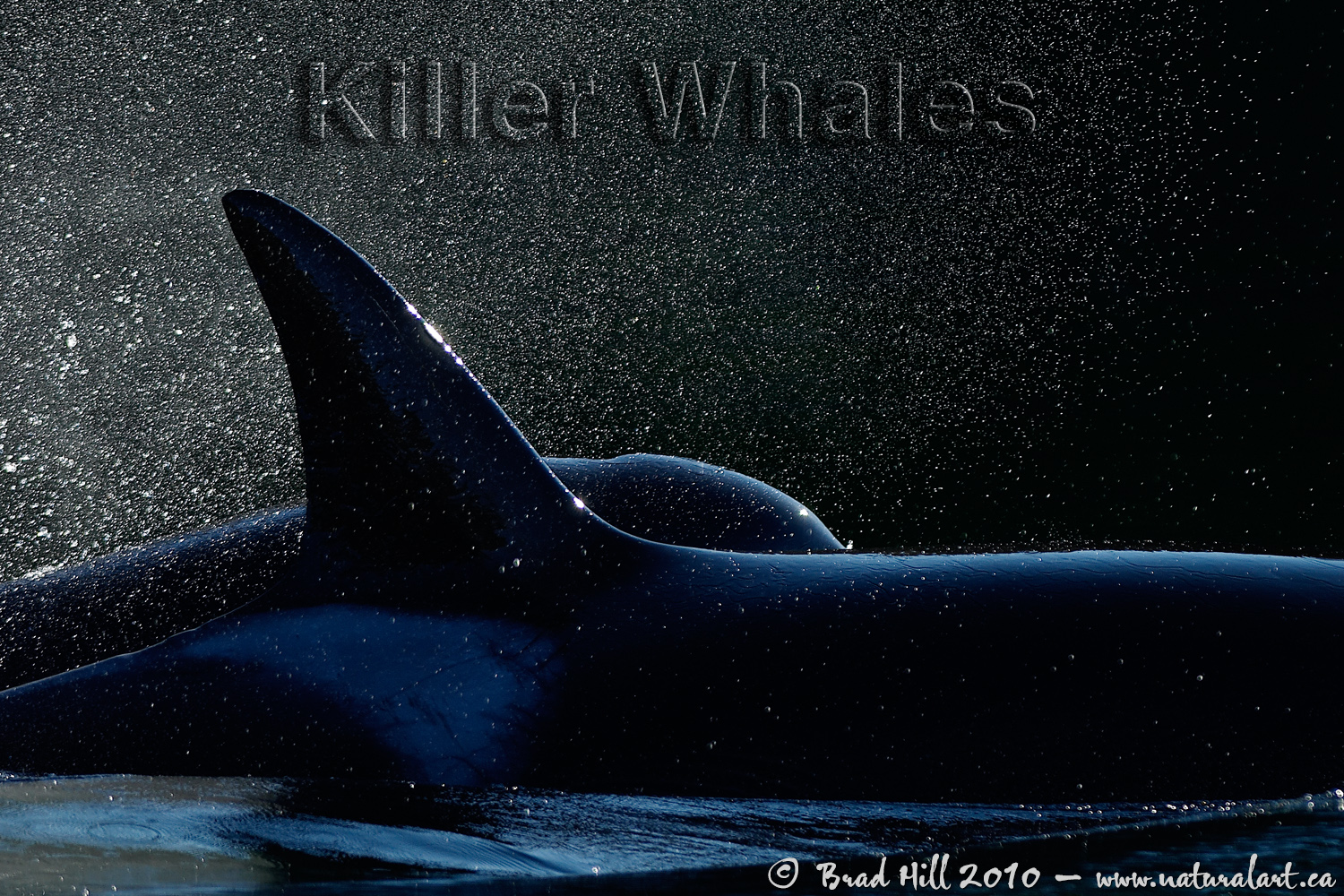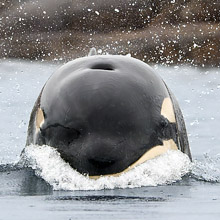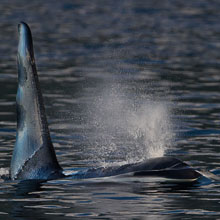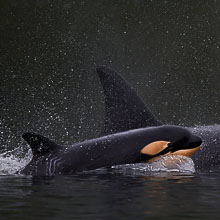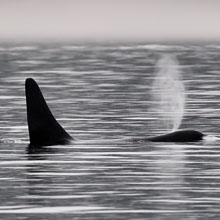Availability: Limited Edition Print
In the Field
Orca Art. Rescue Bay (Great Bear Rainforest), BC, Canada. October 3, 2006.
I captured this image near the tail-end of an enjoyable but not too photographically successful bear photography expedition. Here I caught a female Killer Whale (or Orca) and its calf just after they had surfaced and "blown". The scene was strongly backlit and the shoreline in the background was in extremely dark shade.
Getting this shot presented some real photographic challenges. The lighting was extremely contrasty but incredibly dramatic - it was essential to ensure that the highlights along the edge of the whale's back and those in the water droplets weren't blown out (overexposed). Digital sensors are wonderful at capturing shadow detail, but it's REALLY EASY to lose the highlights. In this case I knew I had to dramatically underexpose the image (based on the light meter's suggested setting). In this case I underexposed by over 2 stops. Focus was another issue - these guys were moving fast and you had to react quickly. I chose my fastest focusing telephoto (as opposed to my longest telephoto). Further compounding the importance of fast and accurate focusing was that in order to freeze the action I had to use a very fast shutter speed and thus a very large aperture (which gave me almost no depth of field).
Ultimately, this photographic scenario illustrated the importance of some really basic field photography truisms: 1) Ya gotta be there; 2) Ya gotta have the right equipment; 3) Ya gotta REALLY know that equipment and how to use it; 4) Ya gotta be ready, and; 5) it really, really, helps to be lucky!
Here's a higher resolution (2400 pixel) version of this dramatic shot:
• Orca Art: Download 2400 pixel image (JPEG: 2.4 MB)
NOTES:
1. This image - in all resolutions - is protected by copyright. I'm fine with personal uses of it (including use as desktop backgrounds or screensavers on your own computer), but unauthorized commercial use of the image is prohibited by law. Thanks in advance for respecting my copyright!
2. Like all wildlife photographs on this website, this image was captured following the strict ethical guidelines described in The Wildlife FIRST! Principles of Photographer Conduct. I encourage all wildlife photographers to always put the welfare of their subjects above the value of their photographs.
Behind the Camera
Orca Art. Rescue Bay (Great Bear Rainforest), BC, Canada. October 3, 2006.
Digital Capture; Compressed RAW (NEF) format; ISO 100.
Nikon D2X with Nikon 300 mm f/2.8G ED-IF AF-S VR lens (450 mm equivalent with digital conversion factor) - hand held (VR turned to "On" and in "Normal" mode).
1/1250s @ f2.8; -2.33 stop exposure compensation from matrix-metered exposure setting.
At the Computer
Orca Art. Rescue Bay (Great Bear Rainforest), BC, Canada. October 3, 2006.
RAW Conversion, including first-pass sharpening, exposure compensation, and tone curve adjustment, using Phase One's C1 Pro. Multiple RAW conversions (3 at different exposure settings) to extend dynamic range of captured image, in this case primarily to 1) retrieve highlight detail in the water droplets and along the front edge of the whale's dorsal fin and 2) retrieve shadow detail on "saddle" along side of adult whale (immediately below the dorsal fin).
All further digital correction on 16-bit TIFF file using Adobe's Photoshop CS2, including compositing and masking of various exposure versions, additional tone curve adjustment, selective saturation enhancement and selective sharpening for web output.
Conservation
Orca Art. Rescue Bay (Great Bear Rainforest), BC, Canada. October 3, 2006.
Ten percent of the revenue generated by this image will be donated to Raincoast.
Species Status in Canada*: Endangered - Northeast Pacific southern resident population; Threatened - Northeast Pacific transient population and the Northeast Pacific northern resident population; Special Concern - Northeast Pacific offshore population.
Killer Whales (Orcinus orca) have an extremely high profile in modern pop culture and have become the "poster child" of a number of conservation groups. In most areas where Killer Whales are found they show a remarkable ability to adapt to a variety of habitats - they are found in all oceans, in water ranging in temperature from below 0 Celsius to almost hot tropical waters, and will occasionally even spend significant amounts of time in brackish water or even rivers.
Because the population sizes of Killer Whales are very low and because they have a very low reproductive rate, they face immediate risk from human-related environmental disturbances, including the immunotoxic effects of toxic chemicals we pour into the oceans and to reduction in prey availability (such as salmon).
These two Killer Whales were photographed along the coast in British Columbia's Great Bear Rainforest. The Raincoast Conservation Society is fighting to protect the Great Bear Rainforest along the central and northern coast of British Columbia. This unique ecosystem harbours a strong population of many high-profile species such as Brown Bears and Gray wolves, plus many species that serve as prey for the Killer Whale. If you are looking for a meaningful way to contribute to the conservation of the Great Bear Rainforest and all its associated species, Raincoast will provide maximal "bang" for your conservation dollars.
For more information on the status of Killer Whales in Canada, go to: http://www.speciesatrisk.gc.ca and search under "Killer Whale".
*as determined by COSEWIC: The Committee on the Status of Endangered Wildlife in Canada












